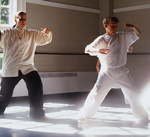“Emei Qigong has had a profound impact on my quality of health, providing skills to manage and negotiate life’s challenges and movements, realizing a richness and contentment in my life.” – Pat Bolger, Master Emei Qigong
Overview
 Qigong is a core component of Chinese Medicine. There are actually many different names for this practice including dao yin, chi kung, chi gong and tajiquan. Chi or Qi (pronounced chee) means “energy,” while kung and gong refer to “force.” The names all pertain to the general act of moving qi (energy, life force). This life force is present in three forms; heaven (tian), earth (di) and humanity (ren), referred to collectively as San Cai or the Three Natural Powers.
Qigong is a core component of Chinese Medicine. There are actually many different names for this practice including dao yin, chi kung, chi gong and tajiquan. Chi or Qi (pronounced chee) means “energy,” while kung and gong refer to “force.” The names all pertain to the general act of moving qi (energy, life force). This life force is present in three forms; heaven (tian), earth (di) and humanity (ren), referred to collectively as San Cai or the Three Natural Powers.
The origination of qigong sprang from a need for humans (possibly of the prehistoric era) to live in harmony in nature and to gain a sense of order (Daoism). In 2400 B.C. the philosophies of qigong led to the writing of I Ching (The Book of Changes) which profoundly influenced the development of ancient China. The progression of qigong paralleled that of acupuncture which began during the Shang dynasty (1766-1154 B.C.). Whereas acupuncture guides qi through probes, qigong does it through breath and coordinated movements. Qigong, and the yoga of India, have some commonalities in the emphasis on energy (prana in India), meditation, and breath work.
Foundational elements of Qigong
- Qi – the energy in us and around us.
- Meridians – the channels throughout the body that transport qi.
- Dan Tian– the energy center of the body located deep in the pelvis (beneath the belly button) which is often a focus of qigong exercise.
- Groundedness – there is a point on the soles of the feet running from below the second toe to the bottom of the ball of the feet. This “bubbling well” is the energy center that connects to the earth qi. Groundedness leads to self-acceptance and inner security.
- Quiet Mind – the state achieved during practice, it is free from anxiety.
- Repetition – repeating the same movements reinforces your commitment to the practice.
- Deepening – as you deepen your practice the notion of repetition falls away since every movement and moment is different.
- Integration – the practice shifts from the conscious to the unconscious mind
- Time – one must commit to the time of practicing and also the time of allowing the body to rebalance and self-heal.
Qigong facts
- A study of hypertensive patients showed an over 15% reduction in mortality for those practicing qigong twice a day (30 minutes each session).
- Multiple studies have demonstrated that tai chi and qigong are excellent ways to promote balance and increase bone density.
- Trying a spiritually connected movement like qigong or tai chi is “letting go to something larger.” – David Forbes, MD
- In qigong it is customary to put the tongue on roof of the mouth (behind the front teeth) which enables us to reconnect the two meridian channels running through our body.
Qigong Resources
** Emei Qigong – Connnecticut – www.emeiqigongchan.com – Editor’s Note: This is a personal favorite, as it is the site of Pat Bolger, the Qigong Master who introduced me to this amazing practice.
Creating a Tai Chi Program – www.hartfordhealth.org/IntMed/manual/taichi.asp – a comprehensive guide on Tai Chi and Qigong from the Integrative Medicine department of Hartford Hospital.
Emei Qigong – US – www.emeiqigong.us – the main website of Emei Qigong and Grandmaster Fu Wei Zhong.
Feel The Qi – www.feeltheqi.com – the site of author and Doctor of Chinese Medicine, Roger Jahnke.
Healing Sounds Qi Gong – taoism.about.com/od/practices/ht/HS_Heart.htm – an easy, relaxing, heart-centered practice to help relieve stress and promote joy.
Qigong Healing – www.qigonghealing.com – A site by Kenneth S. Cohen, Qigong master and author of The Way of Qigong
Qigong Institute – www.qigonginstitute.org – a resource for locating qigong practitioners and information. There is even a section of scientific papers on qigong.
References
Riley, D. Ehling D, Sancier K. (2004). Chapter 11: Movement and Body-Centered Therapies in Integrative Medicine. McGraw Hill Companies.
Ellae Ellinwood (2004). Qigong Basics, Tuttle Publishing
David Forbes, MD. Lecture at The Graduate Institute, April 13 & 14, 2012, Love, Genes and Healing
[Last Updated: 10/25/12]

Comments are closed.